 W
WCutlery includes any hand implement used in preparing, serving, and especially eating food in Western culture. A person who makes or sells cutlery is called a cutler. The city of Sheffield in England has been famous for the production of cutlery since the 17th century and a train – the Master Cutler – running from Sheffield to London was named after the industry. Bringing affordable cutlery to the masses, stainless steel was developed in Sheffield in the early 20th century.
 W
WA variety of eating utensils have been used by people to aid eating when dining. Most societies traditionally use bowls or dishes to contain food to be eaten, but while some use their hands to deliver this food to their mouths, others have developed specific tools for the purpose. In Western cultures, cutlery items such as knives and forks are the traditional norm, while in much of the East, chopsticks are more common. Spoons are ubiquitous.
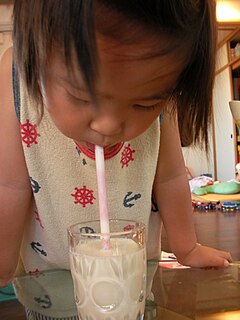 W
WAssistive eating devices include devices ranging from low-tech utensils to high-tech powered robotic eating equipment. Low tech eating devices include utensils, plates and bowls with lips that make scooping food easier. Cups and mugs, and even a standard disposable straw can be considered assistive drinking devices. They are used by people when they have difficulty eating or drinking independently. These devices are typically used for people with disabilities, but can also be used for children or people that have poor dexterity. They can promote independence during meal times, but in many cases also can reduce the caregiver workload during meals. "Assistive eating devices can increase self-care, increase self-esteem associated with increased independence, increase safety during meals, and make meal-time better for caregiver staff…".
 W
WCaviar spoons are traditionally made of inert materials, such as animal horn, gold, mother of pearl, and wood. They range in length from 7 to 13 cm, and have a small shallow bowl that may be either oval or paddle shaped.
 W
WA chopstick rest or Hashioki is tableware, similar to a knife rest or a spoon rest, used to keep chopstick tips off the table and to prevent used chopsticks from contaminating or rolling off tables. Chopstick rests are found more commonly in restaurants than in homes. They come in various shapes and are made from clay, wood, plastic, metal, glass, porcelain or precious stones such as jade. If the chopsticks come in paper sleeves, some people fold the sleeves into chopstick rests.
 W
WChopsticks are shaped pairs of equal-length sticks that have been used as kitchen and eating utensils in most of East Asia for over three millennia. They are held in the dominant hand, secured by fingers, and wielded as extensions of the hand, to pick up food.
 W
WA cocktail umbrella or paper parasol is a small umbrella made from paper, paperboard, and a toothpick. They are frequently associated with tropical drinks and Tiki bars and used as a garnish decoration. They are also used in desserts or other foods and beverages.
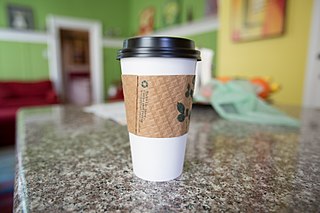 W
WCoffee cup sleeves, also known as coffee sleeves, are roughly cylindrical sleeves that fit tightly over handle-less paper coffee cups to insulate the drinker's hands from hot coffee. Coffee sleeves are typically made of textured paperboard, but can be found made of other materials. Coffee sleeves allow coffee houses, fast food restaurants, and other vendors to avoid double-cupping, the practice of using two nested paper cups for a single hot beverage. Some paper cup holders carry advertisements.
 W
WA drinking straw is a utensil that is intended to carry the contents of a beverage to one's mouth. Straws are commonly made from plastics but environmental concerns and new regulation has led to rise in reusable and biodegradable straws. These straws are often made of silicone, cardboard, or metal. A straw is used by placing one end in one's mouth and the other in a beverage. By employing suction, the air pressure in one's mouth drops causing atmospheric pressure to force the liquid through the straw and into the mouth. Drinking straws can be straight or have an angle-adjustable bellows segment. Drinking straws have historically been intended as a single-use product and several countries, regions, and municipalities have banned single-use plastic straws to reduce plastic pollution. Additionally, some companies have even voluntarily banned or reduced the number of plastic straws distributed from their premises.
 W
WVarious customary etiquette practices exist regarding the placement and use of eating utensils in social settings. These practices vary from culture to culture. Fork etiquette, for example, in Europe, the United States, and Southeast Asia, and continues to change. In East Asian cultures, a variety of etiquette practices govern the use of chopsticks.
 W
WThe Field Ration Eating Device is a small device which serves as a combination of a can opener, a bottle opener, and a spoon. Introduced around 1943, it is issued to the Australian Defence Force in its CR1M ration packs. It is also humorously referred to as the "Fucking Ridiculous Eating Device".
 W
WIn cutlery or kitchenware, a fork is a utensil, now usually made of metal, whose long handle terminates in a head that branches into several narrow and often slightly curved tines with which one can spear foods either to hold them to cut with a knife or to lift them to the mouth.
 W
WGrande Baroque is a sterling silver tableware pattern.
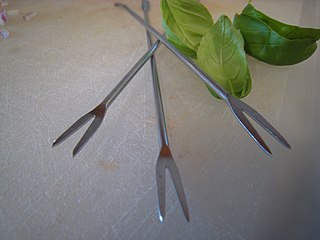 W
WA lobster pick or lobster fork is a long, narrow food utensil used to extract meat from joints, legs, claws, and other small parts of a lobster. Lobster picks are usually made of stainless steel and weigh as much as an average teaspoon. They have a long, textured cylindrical handle, ending in a crescent-shaped moderately sharp pick, or else a small two-tined fork. The other end may have a spoon for scooping out meat from inside the lobster. The lobster pick can also be used with other seafood, such as crab and crawfish.
 W
WA nutcracker is a tool designed to open nuts by cracking their shells. There are many designs, including levers, screws, and ratchets. The lever version is also used for cracking lobster and crab shells.
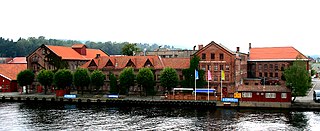 W
WPorsgrund Porcelain Factory is a porcelain flatware company located at Porsgrunn in Telemark county, Norway.
 W
WThe Unistraw Delivery System (UDS) is a patented straw-delivery system created by Unistraw International Limited in 1997, and released commercially in 2005. The UDS can add flavour, energy, vitamins, nutrition, and even pharmaceuticals to liquid sipped through it.
 W
WA skewer is a thin metal or wood stick used to hold pieces of food together. The word may sometimes be used as a metonym, to refer to the entire food item served on a skewer, as in "chicken skewers". Skewers are used while grilling or roasting meats and fish, and in other culinary applications.
 W
WA Splayd is an eating utensil combining the functions of spoon, knife and fork. It was created by William McArthur in the 1940s in Sydney, New South Wales, Australia. There are several manufacturers.
 W
WA spoon is a utensil consisting of a small shallow bowl, oval or round, at the end of a handle. A type of cutlery, especially as part of a place setting, it is used primarily for transferring food to the mouth. Spoons are also used in food preparation to measure, mix, stir and toss ingredients and for serving food. Present day spoons are made from metal, wood, porcelain or plastic. There are a wide variety of spoons that are made of a variety of materials and by different cultures for many different uses and foods.
 W
WSpoon and chopstick rest is a piece of tableware for resting a spoon and chopsticks without touching the table. In Korean cuisine context, it can be referred to as sujeo rest as sujeo is a paired set of spoon and chopsticks, which is very common in Korea.
 W
WA spork is a hybrid form of cutlery taking the form of a spoon-like shallow scoop with two to four fork-like tines. Spork-like utensils, such as the terrapin fork or ice cream fork, have been manufactured since the late 19th century; patents for spork-like designs date back to at least 1874. Sporks are commonly used by fast food restaurants, schools, prisons, the military, backpackers and in airline meals.
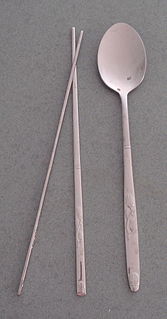 W
WSujeo (수저) is the Korean word for the set of eating utensils commonly used to eat Korean cuisine. The word is a portmanteau of the words sutgarak and jeotgarak. The sujeo set includes a pair of oval-shaped or rounded-rectangular metal chopsticks, and a long handled shallow spoon of the same material. One may use both at the same time, but this is a recent way to speed eating. It is not considered good etiquette to hold the spoon and the chopstick together in one hand especially while eating with elders. More often food is eaten with chopsticks alone. Sometimes the spoon apart from chopsticks is referred to as sujeo.
 W
WA toothpick is a small thin stick of wood, plastic, bamboo, metal, bone or other substance with at least one and sometimes two pointed ends to insert between teeth to remove detritus, usually after a meal. Toothpicks are also used for festive occasions to hold or spear small appetizers or as a cocktail stick, and can be decorated with plastic frills or small paper umbrellas or flags.
 W
WThe Unistraw Delivery System (UDS) is a patented straw-delivery system created by Unistraw International Limited in 1997, and released commercially in 2005. The UDS can add flavour, energy, vitamins, nutrition, and even pharmaceuticals to liquid sipped through it.